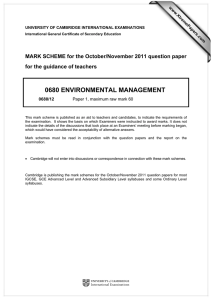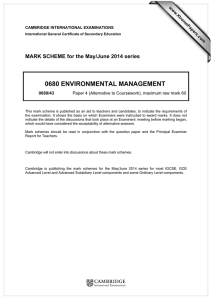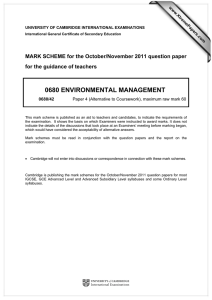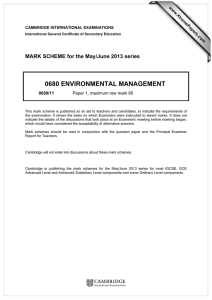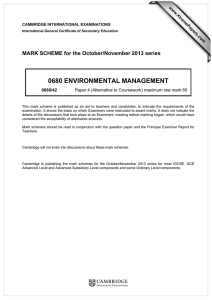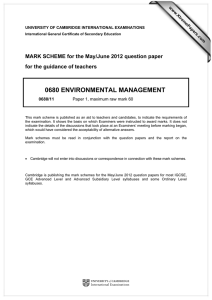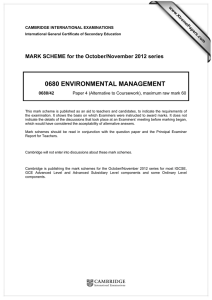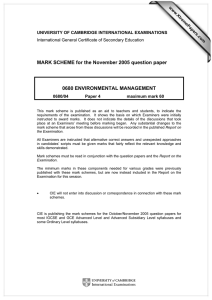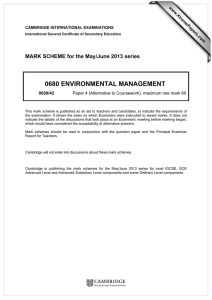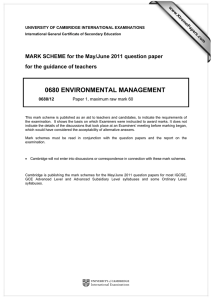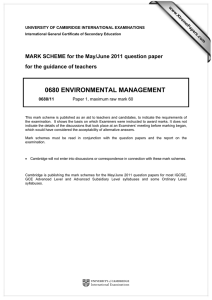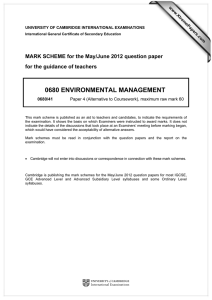0680 ENVIRONMENTAL MANAGEMENT MARK SCHEME for the May/June 2013 series
advertisement
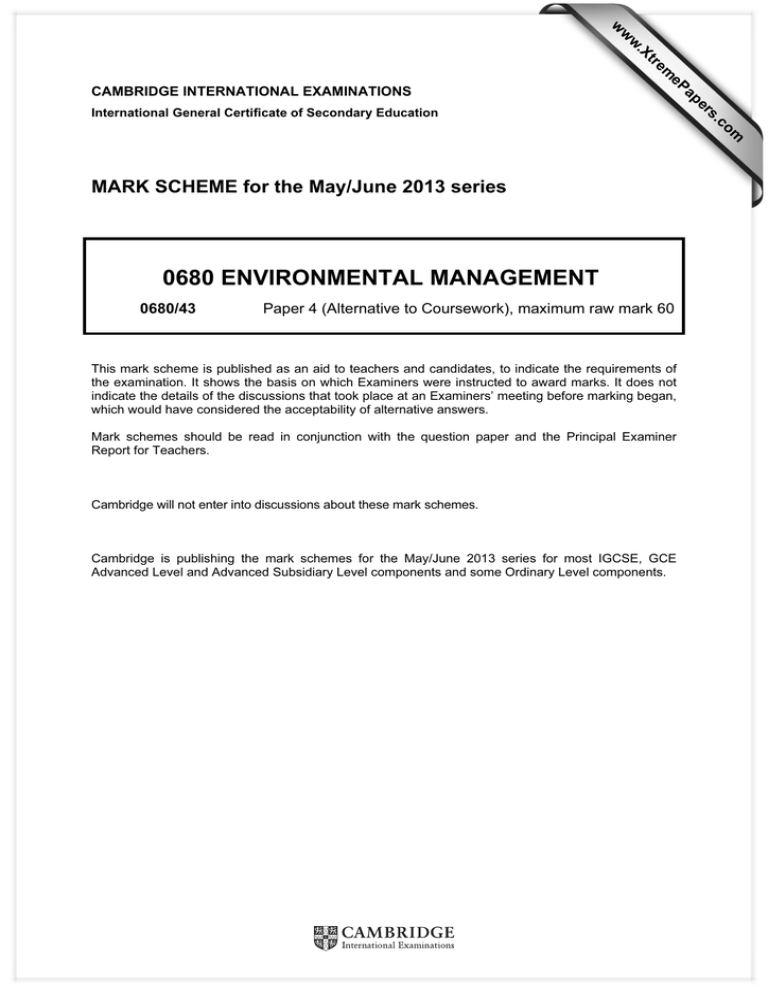
w w ap eP m e tr .X w CAMBRIDGE INTERNATIONAL EXAMINATIONS 0680 ENVIRONMENTAL MANAGEMENT 0680/43 Paper 4 (Alternative to Coursework), maximum raw mark 60 This mark scheme is published as an aid to teachers and candidates, to indicate the requirements of the examination. It shows the basis on which Examiners were instructed to award marks. It does not indicate the details of the discussions that took place at an Examiners’ meeting before marking began, which would have considered the acceptability of alternative answers. Mark schemes should be read in conjunction with the question paper and the Principal Examiner Report for Teachers. Cambridge will not enter into discussions about these mark schemes. Cambridge is publishing the mark schemes for the May/June 2013 series for most IGCSE, GCE Advanced Level and Advanced Subsidiary Level components and some Ordinary Level components. om .c MARK SCHEME for the May/June 2013 series s er International General Certificate of Secondary Education Page 2 Mark Scheme IGCSE – May/June 2013 Syllabus 0680 Paper 43 General notes Symbols used in Environmental Management mark schemes. / separates alternatives for a marking point – other valid ways of expressing the same idea are also credited ; separates points for the award of a mark [3] indicates the number of marks available Italic indicates that this is information about the marking points and is not required to gain credit italic text is also used for comments about alternatives that should be accepted, ignored or rejected. ora or reverse argument – shows that an argument from an alternative viewpoint will be credited AW alternative wording, sometimes called ‘or words to that effect’ – AW is used when there are many different ways of expressing the same idea ( ) the word / phrase in brackets is not required to gain marks but sets the context of the response for credit volcanic underlined words –the answer must contain exactly this word ecf error carried forward – if an incorrect answer is given to part of a question, and this answer is subsequently used by a candidate in later parts of the question, this indicates that the candidate’s incorrect answer will be used as a starting point for marking the later parts of the question © Cambridge International Examinations 2013 Page 3 1 Mark Scheme IGCSE – May/June 2013 Syllabus 0680 (a) (i) a state in the south / south east of the country / south of topic of Capricorn / eq; (ii) second furthest from the equator / nearest to tropic / eq; Paper 43 [1] [1] (b) (i) Any two from: so conditions are the same; same climate; rainfall; soil conditions; pH; eq; [2] (ii) species / variety of apple trees / even spacing within each plot / size of plot; [1] (iii) select same number of trees / specified number 10+; pick all fruits / count all fruits / select trees from different parts of the orchard / describe method for selection; [2] (iv) orientation; plots; labelled axes;; [4] (v) 60 (accept 50–80); only a small increase in yield with extra trees / extra costs not covered by small increase in yield / use of figures to justify; [2] (vi) weight of fruit per tree / size of fruits [1] (c) (i) Any two from: higher density orchards means more costs of fertiliser; pesticides; labour; management of trees [2] these cost not covered unless a good yield (nearly) every year; AVP; (or converse argument) [1] (ii) May–September; (accept June–August or April–November) [1] (iii) 6 × 0.6; = 3.6; (two marks for correct answer only) [2] (iv) Any two from: lower temperatures; higher yields / export more; to avoid reduction of yield due to climate change / global warming in the future; more profits; [2] (d) (i) Any two from: all at same height / specified height; sheltered from direct sun; evenly spaced in orchard / described; [2] (ii) to find out if the orchard is cold enough in winter / to find out if lower yields occur with warmer winters / to predict onset of flowering / select best time for spraying / AVP; [1] (iii) thermometer 2 and 3; max and min temp × 3; (two errors one mark) [2] (iv) Any three from: to find monthly averages; to find temperature ranges (each month); to find how many days/weeks below 7.2 °C; so data is reliable / eq; [3] © Cambridge International Examinations 2013 Page 4 Mark Scheme IGCSE – May/June 2013 Syllabus 0680 Paper 43 (e) (i) 20 m (protected distance); shelter belts more than 10 h / 20 m apart / eq; (ii) one shaded area and to scale; 2 (a) (i) 600; 200; (cubic metres) [2] [1] [2] (ii) Any two from: loss of vegetation cover; loss of animal habitats; loss of biodiversity; dust / noise pollution; [2] (iii) D B B A C A ;;; (Any three correct = 1 mark) [2] (iv) Any four from: heavy metals not broken down by organisms; accumulate in organisms; passed up food chains; death by poisoning of organisms at the top of the food chain; bioaccumulation / biomagnifications; balance of food chain altered / breaks down; [4] (b) (i) discharge rate same(9) or lower, other values lower but related to original values (less than 1.6, 25, 32) pH same (2.5) or higher value(less acidic); [1] (all values / comments needed for 1 mark) (ii) Any five from: random method: use of grid with tapes; random number tables to set coordinates; to place quadrats; count different species in quadrat; use identification book; record results; AVP e.g. use of compass / stakes; or systematic method: use of transect lines; use tapes to place quadrats; at regular intervals; then MPs as above [5] (iii) use same method as before / same number of samples / same position of samples / same time of year; [1] (iv) (3/12 × 100 =) 25 (%); [1] (v) Any two from: soil not protected by vegetation / high interception; so soil erosion possible; so plants will not grow well; [2] (c) (i) seed brought in from other areas and dropped / eq; (ii) bird droppings fertilise plants so they grow faster / or more plants are able to grow; [1] [1] (d) good use of spider diagram facts with some development (not just restating information given);;;;; and AVP, to argue for or against; [5] (max 4 if both arguments given) © Cambridge International Examinations 2013
